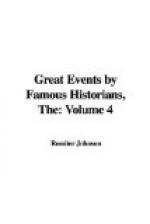Attila’s fame has not come down to us through the partial and suspicious medium of chroniclers and poets of his own race. It is not from Hunnish authorities that we learn the extent of his might: it is from his enemies, from the literature and the legends of the nations whom he afflicted with his arms, that we draw the unquestionable evidence of his greatness. Besides the express narratives of Byzantine, Latin, and Gothic writers, we have the strongest proof of the stern reality of Attila’s conquests in the extent to which he and his Huns have been the themes of the earliest German and Scandinavian lays. Wild as many of those legends are, they bear concurrent and certain testimony to the awe with which the memory of Attila was regarded by the bold warriors who composed and delighted in them.
Attila’s exploits, and the wonders of his unearthly steed and magic sword, repeatedly occur in the sagas of Norway and Iceland; and the celebrated Nibelungenlied, the most ancient of Germanic poetry, is full of them. There Etsel, or Attila, is described as the wearer of twelve mighty crowns, and as promising to his bride the lands of thirty kings whom his irresistible sword had subdued. He is, in fact, the hero of the latter part of this remarkable poem; and it is at his capital city, Etselenburg, which evidently corresponds to the modern Buda, that much of its action takes place.
When we turn from the legendary to the historic Attila, we see clearly that he was not one of the vulgar herd of barbaric conquerors. Consummate military skill may be traced in his campaigns; and he relied far less on the brute force of armies for the aggrandizement of his empire than on the unbounded influence over the affections of friends and the fears of foes which his genius enabled him to acquire. Austerely sober in his private life—severely just on the judgment seat—conspicuous among a nation of warriors for hardihood, strength, and skill in every martial exercise—grave and deliberate in counsel, but rapid and remorseless in execution, he gave safety and security to all who were under his dominion, while he waged a warfare of




